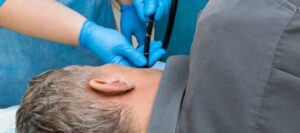Upper GI Endoscopy
 Upper GI Endoscopy is a visual examination of the upper digestive tract using an endoscope, a long, thin tube equipped with a light and a video camera. The upper gastrointestinal tract begins at the mouth, continues through the esophagus and stomach, and ends at the upper part of the small bowel called the duodenum.
Upper GI Endoscopy is a visual examination of the upper digestive tract using an endoscope, a long, thin tube equipped with a light and a video camera. The upper gastrointestinal tract begins at the mouth, continues through the esophagus and stomach, and ends at the upper part of the small bowel called the duodenum.
Some of the purposes of this test are to:
- Diagnose gastrointestinal reflux
- Diagnose the cause of persistent nausea and/or vomiting and abdominal/chest pain
- Diagnose the causes of bleeding
- Detect inflammation; ulcers and abnormal growths of the esophagus, stomach and duodenum
- Diagnose the cause for difficulty swallowing
Preparation
To allow a clear view, the stomach must be empty. It is important not to eat or drink anything for at least 6-8 hours before the exam or have nothing to eat or drink after midnight if your exam is early in the morning. The doctor will instruct you about the use of regular medication, including blood thinners or diabetic treatments, before the exam.
If you are a woman of child-bearing age, you will be tested for pregnancy because medication given during the test can be harmful to a fetus. We also ask you to bring a list of your medications, allergies, health insurance cards and leave all jewelry and valuables at home.
Procedure
Upper GI Endoscopy is usually performed on an outpatient basis, but can be done if hospitalized. You will be asked to change into a gown. After a brief interview about your health history, current medications list, allergies and any questions you may have, an IV will be started by the nurse. A heart monitor, blood pressure cuff, oxygen reader and oxygen cannula (two short prongs fitted in your nose) will help the nurse and doctor monitor you. Permission for the anesthesia and the procedure will be obtained, and then you will be asked to remove your dentures and glasses. Sedation will be given through your IV and your throat may be numbed with a spray or liquid to weaken the gag reflex.
During the test, you will lie on your left side. A plastic mouth guard will be placed in your mouth to prevent tooth damage and to relax the jaw. The endoscope is then gently inserted through the mouth guard and travels to your duodenum. You will be able to breathe easily throughout the exam. The endoscope camera sends images to a monitor so the doctor can look closely inside your body. Your doctor can insert instruments through the scope’s channel to remove polyps, take tissue samples, inject solutions, stop bleeding or destroy problem tissues. The exam takes 15-30 minutes, after which you will be taken to a recovery area.
There is little discomfort with the procedure and patients seldom remember much about it. It takes about an hour to recover from the sedative and for your swallowing and reflexes to return to normal. A small snack will usually be given to you before going home. The nurse will review your discharge instructions. You are then sent home and encouraged to rest. Due to the mild sedation, you should not drive or operate machinery following the exam. For this reason, you should arrange for someone else to drive you home after the exam.
Biopsy results are usually available in 7-10 days after the test.
Side Effects and Risks
A temporary sore throat sometimes occurs after the exam. Some patients may be allergic to the sedative, so please tell the doctor if you have any allergies before the procedure. Serious risks with Upper GI Endoscopy are very uncommon. One risk is bleeding. Others are infection or reactions to anesthesia. In extremely rare cases, a perforation, or tear, in the esophagus or stomach wall can occur. These complications may require hospitalization and, possibly surgery. You may feel bloated or pass gas for a few hours after the exam. Walking may lessen your discomfort.